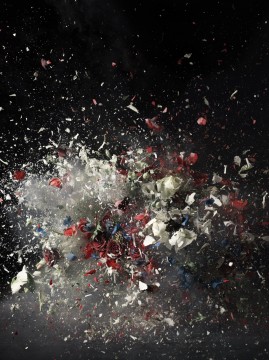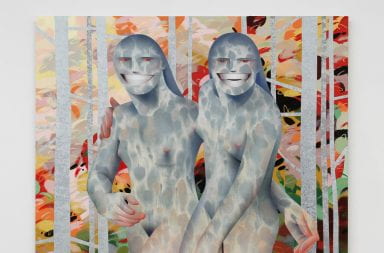
‘Blow Up #1’ — a portion showed above — is a 2007 C-print mounted to acrylic by Ori Gersht that is part of the Pizzuti Collection.
Credit: Courtesy of Pizzuti Collection and CRG Gallery
Violence and beauty rarely work in conjunction, but Israeli photographer Ori Gersht aims to harmoniously fuse the two.
The Pizzuti Collection, a gallery in the Short North curated from the personal collection of real estate developer Ron Pizzuti and his wife Ann, teamed up with the Columbus Museum of Art for the exhibition “Still Life,” which shares a few pieces of Gersht’s photography and video art that find beauty in places with traumatic history.
“Gersht grew up in a beautiful country with beautiful landscapes, but it was a country marred with war and violence,” said Rebecca Ibel, Pizzuti Collection director and curator.
Many of the pieces in “Still Life” drew inspiration from the delicacy of two extremes.
For his works, Gersht revisits places he once lived as well as places that experienced violence during the Holocaust and World War II.
“They deal with very sensitive issues but in a way that is more poignant than political,” said Tyler Cann, CMA’s associate curator of contemporary art.
Despite the title, the subjects of the collection are different than the conventional still life.
“The phrase ‘Still Life’ is an oxymoron; nothing living is truly still, but photographs and paintings are, and Gersht is very interested in their apparent attempt to capture and represent a slice of time,” Cann said.
Gersht uses high speed photography to catch that slice of time. He physically explodes still life arrangements of flowers or fruit baskets, which is then captured on film. Gersht grasps the fine line between life and death, which, in return, highlights the beauty of life as well as its frailty, Ibel said.
“Gersht has gone back to these places where he grew up — places that have experienced much tragedy and violence during the war and the Holocaust — to take photos and films,” she said. “Because of this, there is a lot of pain and trauma in these works.”
Cann also noted that the photographs can be evocative of the moments outside of what was immediately captured.
“He also reminds us that every moment has layers of history embedded within it,” Cann said.
Some Ohio State students said they’re interested in seeing the exhibit. Samantha Carter, a second-year in marketing, said there is a level of numbness to art like that in “Still Life.”
“Stuff like that reflects a lot on our society and the world. It shows that violence is prevalent in our culture, and we’ve grown accustomed and kind of numb to it,” she said.
With photography as a relatively new medium in art, Gersht is treading new territory, Ibel said.
The exhibit opened Aug. 29 and will remain open until Jan. 4 at the Columbus Museum of Art. Museum admission is $12 for adults and $8 for seniors and students over the age of 18. The museum is closed Mondays and admission is free on Sundays.


